Have you ever encountered a tantalizing menu or mouthwatering recipe featuring short ribs? Perhaps you’ve wondered what are short ribs and why they seem to be a hallmark of indulgent comfort food. Well, you’re not alone! Short ribs have been gaining popularity in recent years, but many people are still unsure about what these delectable cuts of meat truly are.
In this blog post, we’ll uncover the mystery of short ribs, exploring their origins, cooking methods, and the irresistible flavors they bring. So, get ready to satisfy your curiosity and dive into the world of short ribs – you may find your new go-to dish for a memorable dining experience!
What Are Short Ribs?
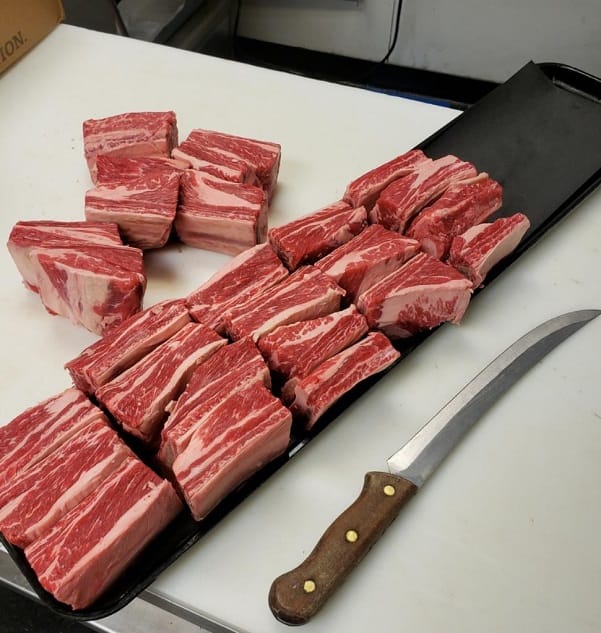
Short ribs come from the lower portion of the cow’s ribs, specifically from the plate and chuck areas. They are a meaty, flavorful cut perfect for slow-cooking methods such as braising or smoking.
One of the most important things to know about short ribs is that they are typically sold in two styles: English and flanken. English short ribs are cut parallel to the bone and are longer, making them perfect for slow roasting. On the other hand, flanken-cut short ribs are cut across the bone and shorter, making them ideal for pan-searing or grilling.
When it comes to cooking short ribs, there are various methods to choose from. Braising is perhaps the most common method, where the short ribs are seared and then cooked in a flavorful liquid such as red wine or beef broth until they are fall-off-the-bone tender. Smoking is another excellent option, which imparts a smoky flavor to the meat while also making it incredibly tender.
No matter how you choose to cook your short ribs, it’s important to remember that they are a rich and hearty cut of meat that pairs well with bold flavors and hearty sides such as mashed potatoes or roasted vegetables.
In conclusion, short ribs are a delicious and versatile cut of meat that every home cook should add to their repertoire. Whether you prefer English or flanken cut, braising, or smoking, these meaty and flavorful ribs are sure to impress.
Other Names for Short Ribs
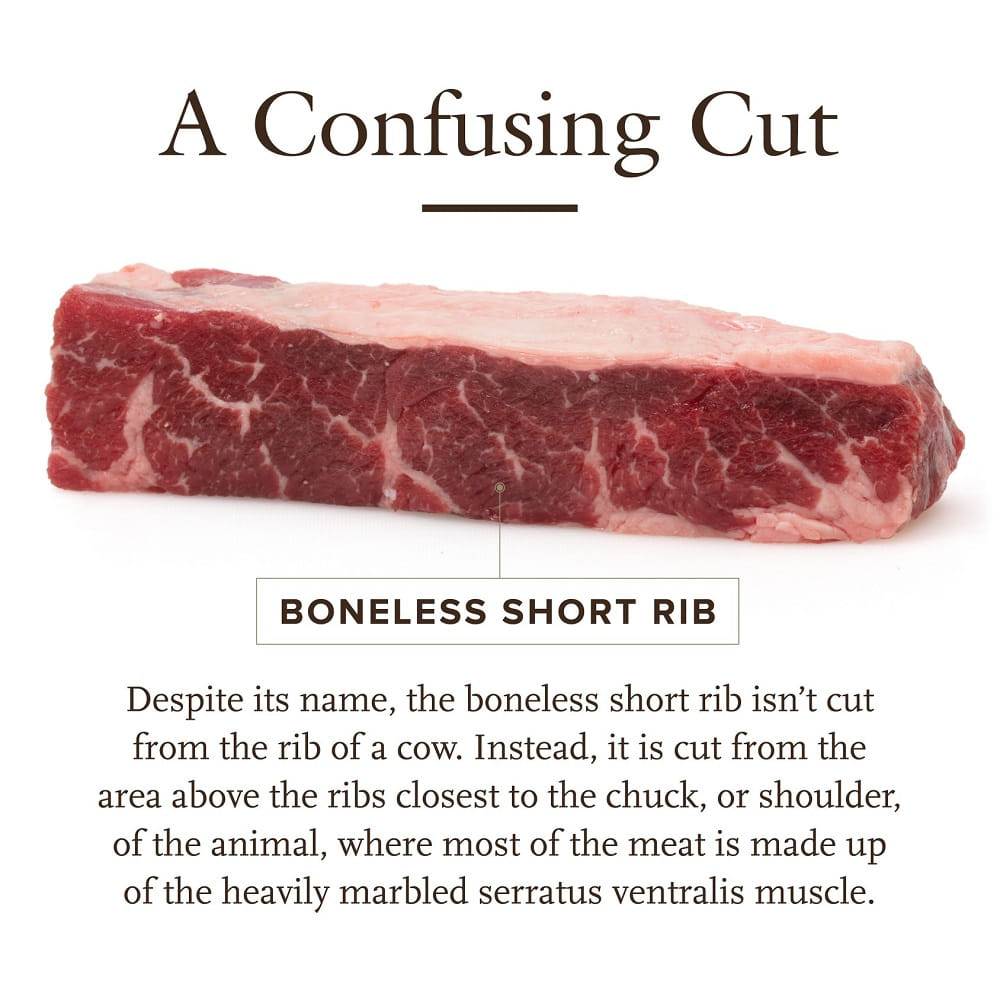
Did you know that beef short ribs are known by various names depending on where you are? It’s fascinating to see how this delicious cut of meat goes by different names in different cuisines and regions. Apart from the well-known term “short ribs,” you might come across them as “braising ribs,” “crosscut ribs,” “English short ribs,” or even “Korean short ribs.”
In the culinary world, you may also encounter flanken short ribs, which are referred to as “crosscut ribs,” “kosher ribs,” or “Korean-style ribs.” These unique ribs have a half-inch thick strip of meat running across four to five bones, making them perfect for Korean Kalbi-style short ribs.
On the other hand, English-style short ribs have a dense slab of meat perched atop the bones. They are often called “braising ribs,” “barbecue ribs,” or “fancy cut ribs.” Additionally, the English cut has a few variations, such as the trimmed English short ribs (with less exterior fat and muscle), the lean English short ribs (with even less fat), and riblets (individual bone slices with short sticks of meat).
Where Do Short Ribs Come From?
Short ribs come from the beef chuck portion of the animal. The five short ribs from the chuck section are too small for other cuts. These ribs are incredibly flavorful, moist, and unctuous, making them a real delight to cook and enjoy. They are often served in two distinct styles – the English cut and the Flanken cut. The English cut is cut parallel to the bone and can be anywhere between 4 to 6 inches in length.
On the other hand, the Flanken cut is cut across multiple rib bones and is around an inch thick for both the bone and the slab of meat attached. Short ribs are known for their abundant marbling and rich beefy flavor. They are full of connective tissue, making them tough if not cooked properly. That’s why they require long cooking periods, usually through low and slow methods like smoking or braising, to break down the connective tissues, make the meat tender, and melt in your mouth.
You can easily find short ribs in supermarkets, but if you want the classic and best cut, I recommend heading to your local butcher or an online meat market. They will be able to provide you with the highest quality short ribs from the chuck area, ensuring you get the most meat and flavor.
Why Are Short Ribs So Expensive?
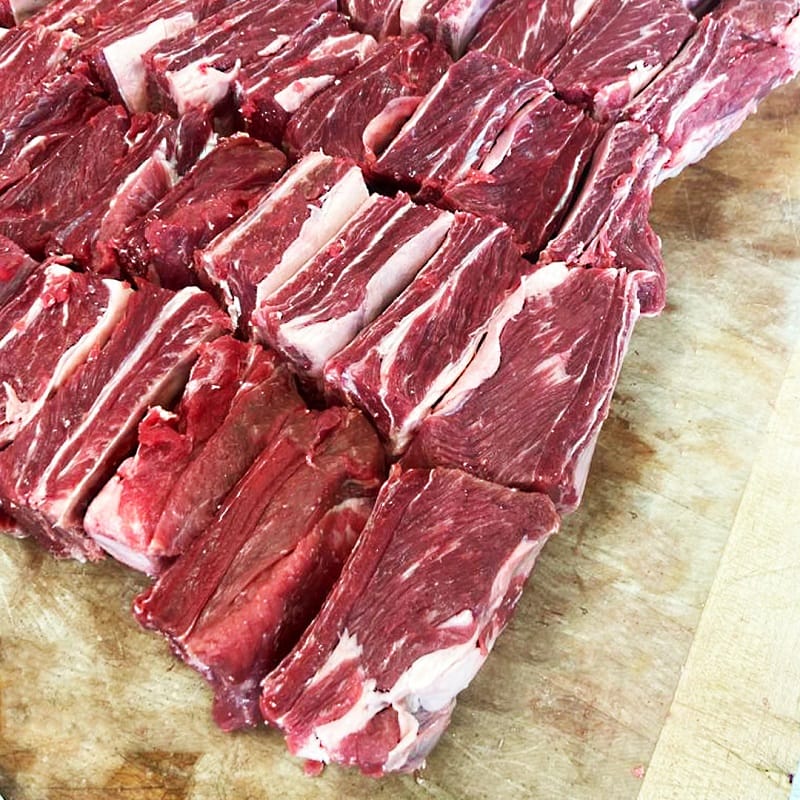
Short ribs are known for their tenderness and rich flavor, but they also come from the valuable section of the cow, which contributes to their higher price. You see, short ribs are cut from the brisket, plate rib, or chuck, yielding larger portions of meat than other cuts. Additionally, the perfect ratio of bone, fat, and meat in short ribs contributes to the rich flavor that many people crave.
Another factor affecting the price is the increasing popularity of short ribs, especially with cooking enthusiasts exploring new recipes and techniques. Moreover, various taxes and transportation costs can also play a role in pushing the price higher.
However, if short ribs are not within your budget or you prefer a more affordable option, alternative cuts can provide a similarly delicious experience. Beef chuck roast, beef back ribs, beef plate short ribs, and lamb shanks or legs can be great substitutes. These cuts offer unique flavors and can be prepared in various ways, such as braising or grilling. So, don’t let the price of short ribs discourage you from enjoying a flavorful and satisfying meal.
Read more:
Flavor, Texture, Fat Content and Tenderness Of Short Ribs
First of all, these ribs are packed with flavor. They have this wonderful beefy taste that melts in your mouth. It’s like a burst of deliciousness with each bite. And the texture, oh boy, it’s so tender and moist. The long and slow cooking process works magic on these ribs, making them incredibly tender. You won’t need a knife because the meat will fall off the bone.
Now, let’s talk about the fat content. Yes, short ribs have a good amount of fat, but don’t worry, it’s not bad. It’s what makes these ribs so flavorful and juicy. The fat slowly melts as it cooks, basting the meat and adding even more richness to the taste. Trust me; you won’t be disappointed.
And finally, the tenderness. Short ribs are quite dense and marbled with fat, so it takes time to get them perfectly tender. But let me tell you; it’s worth the wait. The meat becomes so tender that it practically melts in your mouth. It’s like a taste of heaven with every bite.
How Do Short Beef Ribs Differ From Other Bone-In Rib Varieties In Terms Of Meat Content And Flavor?
When it comes to bone-in rib varieties, they stand out for their meat content and flavor. Unlike other ribs, short ribs have the most meat on them, making them incredibly meaty and satisfying. They are taken from the cow’s chuck and rib areas, meaning they have a dense, beefy flavor that is rich and full-bodied. The meat is a well-marbled, well-worked cut, adding to its tenderness and juiciness.
When cooked low and slow, the fat in the short ribs melts and bastes the meat, resulting in a melt-in-your-mouth texture. It’s like a flavor explosion in every bite. Whether you braise, smoke, or grill them, beef short ribs will impress with their meatiness and intense flavor.
Short Ribs Nutritional
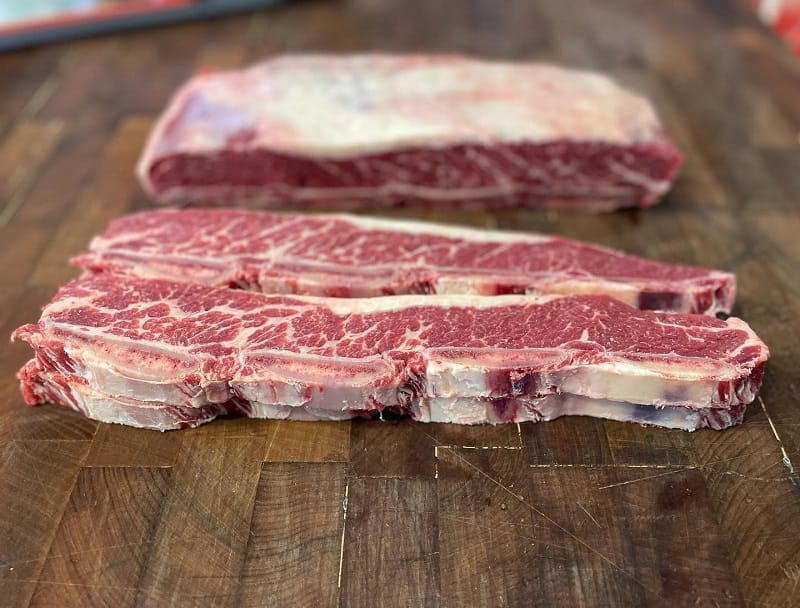
Short ribs are a delicious and flavorful cut of beef that many people enjoy. A serving of 3.5 ounces contains 29 grams of protein, 87 more than 50% of our daily value. Protein is essential for our body as it helps build and repair tissues. Short ribs, being an animal source of protein, provide all the essential amino acids, making it a complete source of protein.
Apart from being a great source of protein, short ribs also contain essential vitamins and minerals. A serving of 3.5 ounces of short ribs provides 3.2 milligrams of iron, 12 milligrams of zinc, 33.5 micrograms of selenium, and 3.92 micrograms of vitamin B12. Iron is essential for producing red blood cells, while zinc helps support a healthy immune system. Selenium acts as an antioxidant and protects our cells from damage, and vitamin B12 is crucial for the normal functioning of our brain and nervous system.
It’s important to note that short ribs are a good source of these nutrients but are also high in calories and fat. A 3.5-ounce serving of short ribs contains 400 calories, with 81% of those calories coming from fat. Therefore, it’s advisable to consume short ribs in moderation and balance them with other nutritious foods.
In conclusion, short ribs provide a tasty and nutrient-rich option for protein intake. They offer important vitamins and minerals like iron, zinc, selenium, and vitamin B12. However, due to their high-calorie and high-fat content, it’s best to enjoy them as part of a balanced diet.
How Do Boneless Beef Short Ribs Differ From Bone-In Short Ribs, And What Are The Advantages Of Each?
When it comes to boneless beef short ribs, the first thing that comes to mind is convenience. These ribs are already trimmed of the bone, making them easier to handle and cook. They are typically cut into uniform pieces, meaning they cook more evenly and are easier to portion. This makes boneless beef short ribs a great option for those new to cooking ribs or who prefer a hassle-free cooking experience.
On the other hand, bone-in short ribs have their own set of advantages. Cooking short ribs with the bone adds more flavor to the meat. The bone acts as a natural flavor enhancer, infusing the meat with richness and juiciness. The bone also helps insulate the meat, resulting in a tender and succulent texture.
In terms of presentation, bone-in short ribs are hard to beat. They have an impressive appearance and can make a beautiful centerpiece for any meal. Plus, there’s something satisfying about gnawing on the bone and savoring every last bit of meat.
Ultimately, the decision between boneless beef short ribs and bone-in short ribs come down to personal preference. If you’re looking for convenience and easy cooking, boneless beef short ribs are the way to go. However, bone-in short ribs are perfect if you’re seeking maximum flavor and a show-stopping presentation. Whichever you choose, one thing is certain – you’re in for a delicious and satisfying meal.
How Many Short Ribs Per Person?
When it comes to serving short ribs, there are a few factors to consider to determine how many per person. Generally, the size and weight of the short ribs will determine the serving size. A per-person estimate of 1 to 3 short ribs is recommended. However, it’s important to keep in mind that short ribs have a high percentage of bone, so they yield less meat per pound.
Depending on the type of short rib, a single rib might be sufficient for one person. For example, English cut ribs are often sold in racks of 3 to 4 ribs, while flanken-style ribs are sliced across the bone and are about 1/2 inch thick. Each rib should weigh between 1 to 2 pounds, making it easy to estimate your serving sizes with the guideline of 1 rib per person.
It’s worth considering the overall menu, the types of side dishes being served, and the demographics of the guests when determining the serving size. It’s also important to remember that short ribs are quite rich, so some guests may have a hard time finishing even one rib.
How to Prepare Short Ribs for Grilling or Smoking?
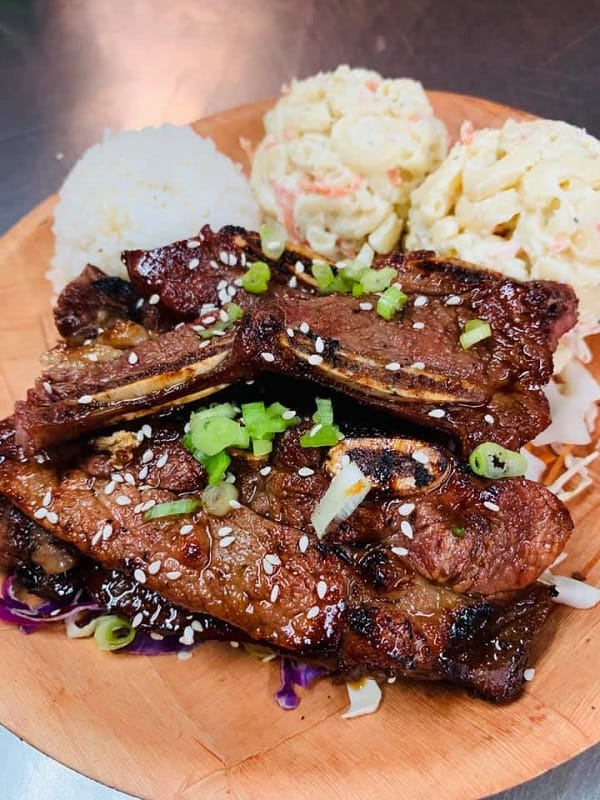
I have a simple and delicious way to prepare short ribs for grilling or smoking.
- First, preheat your smoker or grill to 225°F (107°C). Next, trim any excess fat and remove the membrane from the top of each short rib. This will allow the smoke to penetrate the meat better. If you have time, you can dry brine the ribs overnight in the fridge for an even juicier result. Otherwise, you can season them immediately before cooking.
- I recommend using a flavorful dry rub for the ribs. You can make your own using chili powder, smoked paprika, salt, brown sugar, and other spices, or use your favorite store-bought rub. Make sure to coat each side of the ribs evenly with the rub, gently pressing it into the meat.
- Once preheating your smoker or grill, place the short ribs bone side down directly on the grill grates. Insert a digital meat thermometer into the thickest part of a rib. Close the lid and let the ribs smoke for about 3 hours. During this time, spritz the ribs every hour with apple cider vinegar and water. This will help develop a flavorful crust and keep the meat tender.
- After 3 hours, continue smoking the ribs until they reach an internal temperature of at least 205°F (96°C). If the ribs are not tender enough, you can continue smoking until they reach 210°F (99°C). If desired, apply a thin layer of your favorite BBQ sauce during the last 30 minutes of cooking.
- Once the ribs are done, remove them from the smoker or grill and rest for 5-7 minutes. Then, slice the meat from the bone and serve. The result will be fall-apart, mouthwatering smoked short ribs with a flavorful crust. Enjoy!
Note: The cooking time may vary depending on the thickness of the ribs, so it’s essential to use a meat thermometer to ensure they are cooked to perfection. Don’t forget to remove the membrane from the top of the ribs before cooking, as it can be tough to chew. Also, choose a light-flavored wood such as cherry, pecan, apple, or oak for smoking, as hickory or mesquite wood may overpower the flavor of the ribs.
What Are The Ideal Cooking Methods For Short Beef Ribs?
I have spent countless hours perfecting my cooking methods to achieve the most tender and flavorful results. Through trial and error, I have discovered a few ideal cooking methods that elevate the taste and texture of this delicious cut of meat.
- First and foremost, I highly recommend the slow-cooking method. This involves cooking the beef short ribs at a low temperature for an extended period. Typically, this involves braising the meat in a flavorful liquid, such as beef broth or red wine. The slow cooking process allows the meat to become fall-off-the-bone tender and infuses it with the rich flavors of the braising liquid.
- Another fantastic cooking method for beef short ribs is smoking. This method imparts a smoky flavor to the meat that is hard to replicate with any other cooking method. The key to smoking beef short ribs is to use a low and slow approach, which allows the smoke to penetrate the meat fully. I recommend using a mixture of hardwoods, such as hickory and oak, to create a well-rounded flavor profile.
- Grilling beef short ribs is also an excellent option for those who prefer quicker cooking. However, it is important to note that this method requires extra care to prevent the meat from becoming tough and chewy. To achieve perfectly grilled beef short ribs, I recommend using a two-zone fire and cooking the meat over indirect heat until it reaches your desired level of doneness.
- Finally, when all else fails, the trusty oven can always be relied upon to cook beef short ribs perfectly. Season the meat with your favorite spices and herbs, place it in a roasting pan, and cook it in the oven at a low temperature until it is tender and juicy.
How to Cook Beef Short Ribs
First, make sure to season the short ribs with salt and pepper. This step brings out the flavors. Next, heat a large skillet over high heat and sear the short ribs on each side for about 60 seconds. This adds a nice crust and locks in the juices.
Now, it’s time for the oven. Preheat it to 275°F and place the ribs in a baking dish. You want to have the bone side facing down. Cover the dish tightly with aluminum foil to keep all those amazing flavors locked in. Pop it in the oven for around 3 ½ to 4 hours. You’ll know they’re done when the meat is pulling away from the bone and is fork-tender.
If you prefer using a slow cooker or instant pot, those work too! Just adjust the cooking time accordingly. Another essential thing to note is that you can use boneless or bone-in short ribs for this recipe. Personally, I prefer bone-in for that extra flavor, but both will work just fine.
Once they’re done cooking, dress them up with your favorite spices and sauces. I love adding barbecue sauce or a mix of ketchup and brown sugar for a sweet, tangy glaze.
FAQs
Are Short Ribs Beef or Pork?
Short ribs are beef. They come from the lower 3-6 inches of a cow’s rib cage near the breast bone. They contain large amounts of connective tissue that needs long hours of cooking at low temperatures to render and become tender. Short ribs are typically cut in 2 main ways: parallel to the bone, common in American barbecue, or across the bones in thinner slices known as Flanken Cut, common in Hawaiian and Korean cuisine.
It’s important to note that the pork equivalent of beef short ribs are spare ribs, which are not typically referred to as short ribs. Spare ribs come from the lower part of the rib cage near the breast bone. So, if you’re looking for short ribs, know they are beef, not pork.
Do Short Ribs Have Bones?
Yes, short ribs have bones. Short ribs earned their name because they contain a short piece of the rib bone and its surrounding meat. So, when you enjoy short ribs, you get the flavorful meat attached to the bone. Boneless short ribs are also available but are prepared by removing the rib bone. However, bone-in short ribs are highly appreciated for their rich and meaty flavor. They are perfect for slow cooking methods, like braising or sous vide, which help to tenderize the meat and enhance its flavors.
What Is The Role Of The Serratus ventralis Muscle In The Composition And Tenderness Of Beef Short Ribs?
The Serratus ventralis muscle plays an important role in the composition and tenderness of beef short ribs. This muscle, located in the rib area of the cow, contributes to the overall flavor and texture of the meat. It helps to support the rib cage and aids in the movement and stabilization of the shoulder blade.
The Serratus ventralis muscle is composed of lean meat fibers that provide a rich, beefy flavor. It also adds tenderness to the short ribs, making them more enjoyable. When cooked properly, the Serratus ventralis muscle adds a succulent and melt-in-your-mouth texture to the beef short ribs.
Conclusion
In conclusion, if you’re a meat lover, short ribs are cut that you won’t want to miss. Their unique flavor and texture make them a delicious addition to any meal, and their versatility means that you can prepare them in various ways to suit your taste. So, what are short ribs? They’re a delicious and flavorful cut of beef that you won’t want to pass up.
References:
- https://healthfully.com/261909-nutritional-information-of-beef-ribs.html
- https://en.wikipedia.org/wiki/Short_ribs
- https://www.bhg.com/recipes/how-to/cooking-basics/how-to-braise-short-ribs/

Hello! I’m Wyman Brooks, the owner of Tired Texan HairStyle and Beauty. My journey in the beauty industry began with a simple passion for hair and aesthetics, and over the years, I’ve turned that passion into a thriving business.
At Tired Texan, we pride ourselves on providing a welcoming and friendly environment where clients can feel relaxed and rejuvenated. We offer a wide range of services, from stylish cuts and vibrant color treatments to rejuvenating spa services. My team and I are dedicated to helping each client look and feel their best.
